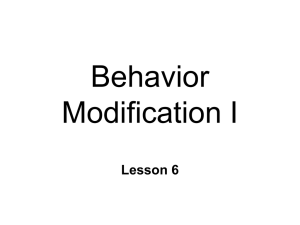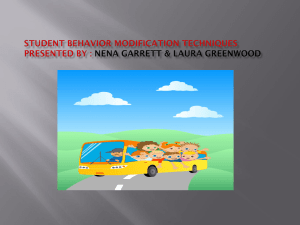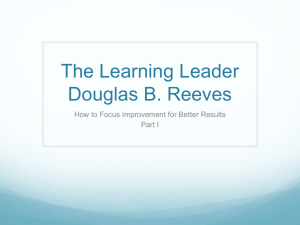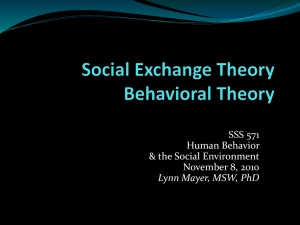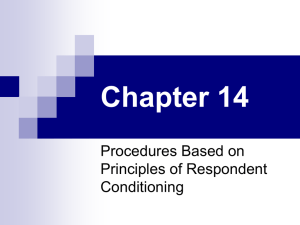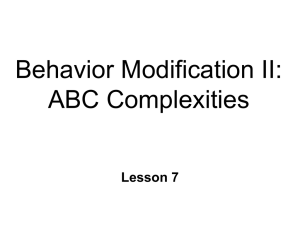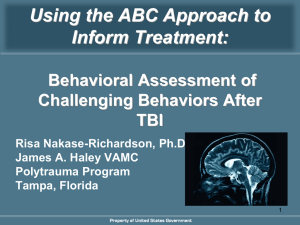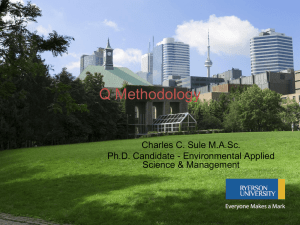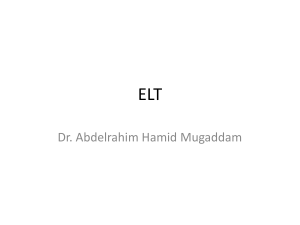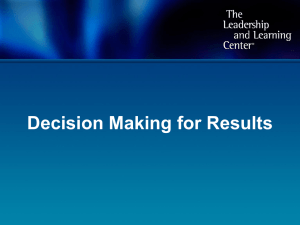Behavior Analysis
advertisement
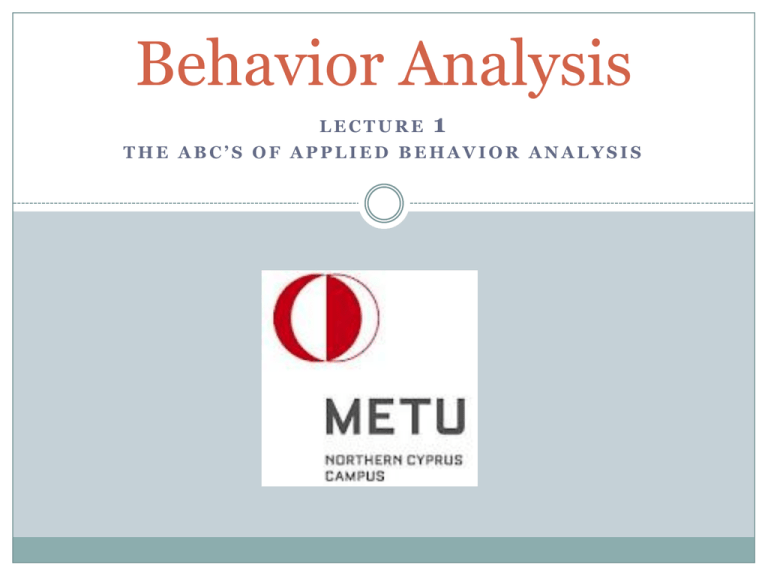
Behavior Analysis LECTURE 1 THE ABC’S OF APPLIED BEHAVIOR ANALYSIS Lecture structure Tuesday – Wednesday - lecture exercises and tests Behavior Analysis BA is a young field – about 50 years old Because its so young people are still arguing about its definition We are going to go with a simple and short definition Behavior Analysis is the science of behavior change. Behavior Analysis In other words, the main focus of behavior analysis is how and why behavior changes. However there is a more conventional definition that most behavior analysts would find satisfactory Behavior analysis is the study of functional relations between behavior and environmental events Behavior Analysis This, more difficult definition, requires that you understand 3 concepts; Functional relations, Behavior Environmental events Functional Relations A functional relation is the tendency of one event to vary in a regular way with one or more other events The simplest sort of functional relation is ‘if x, then y’. This means that if event X occurs, then event Y occurs. The two events are connected so that you can reliably predict that whenever X occurs, Y occurs. For example, if I flick the light switch off, the rooms becomes dark Science can be defined as the search for functional relations among events. Our job, as behavioral psychologists, is to spot the functional relations between peoples behavior and the environment. But what do we mean by behavior? Behavior Someone might suggest that behavior is ‘what people do’ However, our definition is more precise that this; Behavior: anything a person does that can be observed Why? If a tree falls in a forest and nobody is around, does it make a sound when it hits the floor? Psychology is a science. This means, if we cant observe it then it doesn't’t exist. Behavior What about thinking and feeling? These are behaviors, but they are different because they can only be observed by the person experiencing them. This distinction between actions and thoughts/feelings is important For example: You can walk across the room and drink some beer, or you can think about walking across the room and drinking some beer Both are behaviors, but what's the major difference? In one case, you drink the beer Thoughts and feeling don’t have the same effect on the environment that actions have. Actions usually have measurable effects, making it possible for other people to observe them. Thoughts and feelings don’t. Behavior For this reason we have two definitions of behavior: Overt Behavior: behavior that can be observed by someone other than the person performing it Covert Behavior: behavior than can be observed only by the person performing it. Behavior There is also another way of classifying behavior that divides into two categories: Respondent behavior Operant behavior Respondent behavior Respondent behavior is behavior that is most readily influenced by events that precede it It can also be referred to as reflexive behavior. Respondent behavior is the kind of behavior people usually describe as involuntary or reflexive It is behavior that is preceded and readily produced by a specific environmental event Examples include: The flow of acids into the stomach in response to food Blinking an eye when a speck of dust hits it Emotions such as anger fear and love may cause physiological responses i.e. heart rate, breathing patterns, sweating Operant behavior Operant behavior is behavior that is readily influenced by events that follow it Example; if you picked up a hot iron, then the behavior of picking up the hot iron and burning yourself will affect the probability of repeating that behavior in future. Operant behavior includes the majority of behaviors that we can think of Behaviorists often talk about the respondent / operant distinction by saying that respondent behavior is elicited (no choice), whereas operant behavior is emitted (choice) Review Overt Operant Respondent Covert Behavior Every persons behavioral repertoire is composed of some combination of these 4 types of behavior A behavioral repertoire is all the things an individual is capable of doing at any given moment Anything you can do is part of your behavioral repertoire. Something you used to do but don’t anymore is no longer part of your behavioral repertoire. The concept is important because much of BA is about changing behavioral repertoires. Environmental events Remember our definition of BA Behavior analysis is the study of functional relations between behavior and environmental events In behavior analysis were looking for informative relationship between our behavior (respondent, operant, covert and overt) and environmental events. What is an environmental event? Environmental events An environmental event refers to any event in a persons environment that can be observed Environmental events are the kinds of things we usually refer to as experience But remember here that were talking about physical events, that have some sort of measurable effect Behavior analysts are interested in the effects of events in the external environment on behavior. Environmental events As human beings we are great at spotting and describing environmental events, in many different ways; colour, shape, size brightness etc However one feature of experience deserves comment here; the temporal relation of the event to the behavior The word temporal means having to do with time, so were talking about the relationship, in time, of environmental events to behavior. Environmental events Most environmental events can be thought of as falling into two categories, depending on their temporal relation to the behavior: Antecedents are environmental events that occur before a behavior Consequences are environmental events that occur after the behavior The ABC’s of behavior analysis Antecedents - Behavior - Consequences Behavior analysis is the search for functional relationships among behavior, and its antecedents and consequences Certain antecedents will make a behavior more likely to occur, and other may make it less likely to occur And certain consequences may make the behavior they follow likely to occur again, whilst others may make the behavior unlikely to be repeated But more about this later! Learning history The effects of antecedents and consequences are cumulative In other words, all of our past environmental events (experience) will influence a persons present behavior This means that we each bring our own unique learning history to every situation Learning history: all the environmental events (antecedents and consequences) that have affected the persons behavior up to the present Applied behavior analysis So those are the basics of behavior analysis, however were much more interested in a field called Applied Behavior Analysis Applied behavior analysis is the attempt to solve behavior problems by providing antecedents and/or consequences that change behavior In other words; BA is concerned with understanding how environmental events change behavior; APA is concerned with using environmental events to change behavior is desirable ways Our focus in this course on APA; solving behavior problems by altering antecedents and consequences Behavior problems Some problems are adaptive Isn't is good to be scared of snakes? They can kill us right? Behavior becomes problematic when the fear impacts on a persons life, and their actions It can be difficult to engage in a task when your thinking about an unpleasant experience Lets look at some common problems and see if we can find solutions to them Behavior problems Problem Afraid of snakes Obsessed by bad thoughts Too shy Cant read Solution Behavior problems Much of the time, behavior problems occur either because a behavior is occurring too much, or because a behavior is occurring not enough The job of the behavior analyst is to change the frequency of behavior As an example, the chief difference between a good student and a poor student has to do with how often each performs desirable and undesirable acts The medical model Behaviorists maintain that troublesome behavior is the problem, and that altering the frequency of the behavior will solve the problem The medical model, on the other hand, views the problem as being beneath the surface. Medical model: the view that behavior problems are merely the symptoms of an underlying disorder This model is more or less accepted by most psychologists, teachers social workers and many other that deal with behavior problems Problems with the medical model Its definitions are measured by frequency of behavior, rather than underlying causes For example, if you take away inappropriate speech from an autistic person then you have literately made them less autistic It promotes labeling of people with psychological disorders which then affects the way they feel about themselves, as well as the way other people feel about them BA focuses on observable behavior, rather than a mysterious, comorbid and unseen disorders However Behavior analysis is difficult Solving behavior problems is harder than it looks. Always remember Daniels Dictum here; Daniels Dictum: if you think this stuff is easy, you're doing it wrong! As you learn about reinforcement and extinction and shaping and all the rest of it you will think its easy. It will sound easy. However, this course merely prepares you for greater training in BA, rather than the ability solve complex behavior problems in the real world. Flash cards Lets go over some flash cards! You will be tested on these every few weeks. This will be 25% of your final grade! Flash cards Behaviour Analysis: study of functional relations between environmental events and behavior science of behavior change Functional relation: tendency of one event to vary in a regular way with one or more other events Behavior: anything a person does that can be observed Overt behavior: behavior that can be observed by someone other than the person performing it Covert behavior: behavior that can be observed only by the person performing it Respondent behavior: behavior that is most readily influenced by events that preced it; reflexive behavior Operant behavior: behavior that is readily influenced by events that follow it Flash cards Behavioural repertoire: all things an individual is capable of doing at any given moment Environmental event: any event in a person's environment that can be observed Antecedents: environmental events that occur before a behavior Consequences: environmental events that occur after a behavior Learning history: environmental events (antecedents and consequences) that have affected a person's behavior up to the present Flash cards Applied behavior analysis: the attempt to solve behavior problems by providing antecedents and/or consequences that change behavior Medical model: view that behavior problems are merely symptoms of an underlying psychological disorder Symptom substitution: idea that if a behavior problem is solved without resolving the underlying psychological disorder, another behavior problem will take its place Daniel's dictum: if you think this stuff is easy; you're doing it wrong
